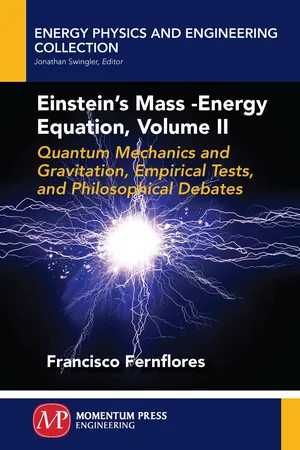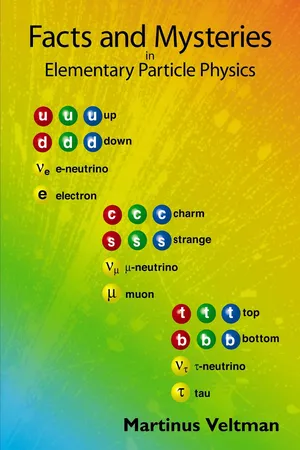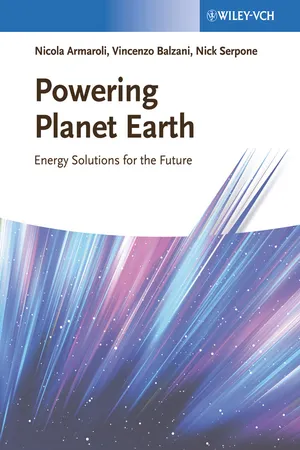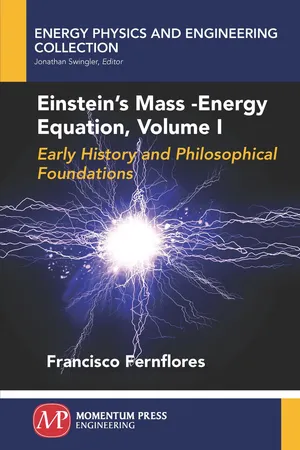Physics
Mass Energy Equivalence
Mass-energy equivalence, described by Einstein's famous equation E=mc^2, states that mass and energy are interchangeable and can be converted into each other. This concept revolutionized physics by showing that mass can be considered a form of energy and vice versa, leading to developments in nuclear energy, particle physics, and cosmology.
Written by Perlego with AI-assistance
Related key terms
Related key terms
1 of 4
Related key terms
1 of 3
4 Key excerpts on "Mass Energy Equivalence"
- eBook - ePub
- Francisco Fernflores(Author)
- 2017(Publication Date)
- Momentum Press(Publisher)
CHAPTER 3
CONTEMPORARY DEBATES AND INSIGHTSThere tend to be two types of discussions in the contemporary physics literature about Einstein’s mass–energy relation. First, there are more historically focused discussions among physicists, and historians and philosophers of physics, concerning whether or not Einstein ever really correctly derived the direct proportionality between mass energy codified in his famous equation, and if he did, when he did. Although we have already appealed to some of this work, in this chapter we wish to examine some of this literature for inevitably it contributes to a more clear understanding of Einstein’s influential result.The other type of discussion in the contemporary literature straddles two issues: (1) How should the relativistic mass–energy relation be taught? and (2) What is the best way to understand what it means to say that mass is “converted” into energy (or vice versa) or that mass and energy are “equivalent?” Papers that address these questions have tended to appear in journals such as the American Journal of Physics and the European Journal of Physics , i.e., journals that are primarily aimed at physics educators in higher education.In this chapter, we will examine some key contributions to this literature, because we are seeking philosophical clarity concerning the meaning and use of expressions involving both the “conversion” and “equivalence” of mass and energy. Note, for instance, that although talk of “converting” mass into energy is fairly common, not only in presentations of science for the layperson but also in physics education, one seldom hears physicists talk about energy being “converted” into mass. Similarly, one does, from time to time, still find the odd physicists (or scientist or philosopher more generally) talking about matter - Martinus J G Veltman(Author)
- 2003(Publication Date)
- WSPC(Publisher)
2 . Indeed it is in particle physics that some very remarkable aspects of the theory of relativity are most clearly demonstrated, not just the energy-mass equation. Another example is the lifetime of unstable particles, in particular the muon. The lifetime of a moving muon appears to be longer in the laboratory, in accordance with the time dilatation predicted by the theory of relativity.Thus the mass-energy must be included when considering the relation between energy and momentum. The figure shows the relation between energy and momentum for two different particles, respectively with masses m and M . We have taken M three times as large as m . For zero momentum the energy is simply mc 2 for the particle of mass m and Mc 2 for the particle of mass M .This figure is really the all-important thing in this Chapter. Understanding it well is quite essential, since we shall draw a number of conclusions from it. In itself it is simple: the curve shows the relation between momentum and energy for a single particle. Given the momentum of a particle of mass m one can find the corresponding energy by using the curve for mass m . If the momentum is zero then the energy is mc 2 .In drawing the figure one must make a choice of units. We have drawn a figure corresponding to a choice of units such that the speed of light is one. For very large positive or negative momenta energy becomes very nearly equal to the magnitude of the momentum. In the figure that we have drawn the diagonal lines represent the relation energy = ± momentum. The curves approach these diagonal lines for large momenta. The diagonal lines define the light cone; the reason for that name shall become obvious soon.- eBook - ePub
Powering Planet Earth
Energy Solutions for the Future
- Nicola Armaroli, Vincenzo Balzani, Nick Serpone(Authors)
- 2012(Publication Date)
- Wiley-VCH(Publisher)
frozen energy that can be converted into more familiar forms: kinetic energy, thermal energy, and so on.In the formula, the letter c represents the speed of light in vacuum. Raised to the second power, it has an even larger numerical value. So, since the right and the left hand sides of the Einstein equation must be numerically equal (otherwise, what kind of equation would it be?), and sincec2is on the side of m , to obtain massive amounts of energy we need only convert small quantities of mass.Every time you produce energy of any kind, quantities of mass – large or small – largely disappear. This dematerialization recalls some improbable science fiction movies and makes us a little bit skeptical. But that’s the way it is, folks. The energy consumed in a month from a huge megalopolis – for example, modern London – is comparable to the energy frozen in the mass of this book. The unfortunate destruction of Hiroshima and Nagasaki in World War 2 occurred by converting only a few grams of matter into energy; a small amount, but certainly a measurable one.Nuclear fission allows the conversion of materials into energy very efficiently, but, as we shall see later, it leaves extremely hazardous wastes. A kilogram of uranium in a nuclear power plant can generate 50 000 kilowatt-hours of energy, while 1 kg of coal in a thermal power station produces only 3 kilowatt-hours. Einstein’s equation is valid in both cases. The amount of matter that evaporates to become energy is dramatically higher in uranium than in coal.For nearly 5 billion years, the Sun has converted 4.4 billion tonnes of hydrogen every second into electromagnetic energy through nuclear fusion processes at temperatures well above 10 million degrees. A tiny fraction of this endless energy flux lightens our days. Of course, Einstein’s equation also suggests that it is possible to convert energy into mass. This has been verified by means of some very complicated experiments. It is possible to create new particles of matter by concentrating huge amounts of energy into a small volume of space. - eBook - ePub
- Francisco Fernflores(Author)
- 2017(Publication Date)
- Momentum Press(Publisher)
Eqn. (2.36) . Einstein then concludes:One is therefore already inclined at this point to grant a real significance to this term mc 2 , to view it as the expression for the energy of the point at rest. According to this conception, we would have to view a body with inertial mass m as an energy store of magnitude mc 2 (“rest-energy” of the body) [31 , p. 49].What is clear from the manuscript, which is a sort of review of special relativity that sometimes elaborates or illustrates in new ways Einstein’s previously published results, is that as late as 1912 Einstein still emphasized the electromagnetic origins of special relativity.Yet, in §13 of the manuscript, it is as if although he believes, as he stated in “On the electrodynamics of moving bodies,” that the results he derives should also apply to “ponderable bodies” because “a ponderable material point can be made into an electron (in our sense) by adding to it an arbitrarily small electric charge” [17 , p. 170], he displays a certain lack of confidence with results that are so derived. After Einstein discusses how one could change the energy of a body by, e.g., heating it, and how this would lead to an increase in the inertial mass of the object, Einstein says: “We will show in the next section that this latter consequence [i.e., that the inertial mass of a body changes in the same sense as its ‘rest-energy’]—if the theory of relativity is correct—must really hold” [31 , pp. 49–50]. Einstein then suggestively titles the next section of the manuscript, i.e. §14, “The inertia of energy.”In §14, Einstein now points out that if the mass of the plate is M , we can regard the energy of the plate as given by(2.38)Although Einstein does not say so explicitly, this seems to assume the remark made in his original 1905 paper on relativity [17] that we can always regard a ponderable body as an “electron,” because we can always add an arbitrarily small charge. Furthermore, Eqn. (2.38)
Index pages curate the most relevant extracts from our library of academic textbooks. They’ve been created using an in-house natural language model (NLM), each adding context and meaning to key research topics.
Explore more topic indexes
Explore more topic indexes
1 of 6
Explore more topic indexes
1 of 4



